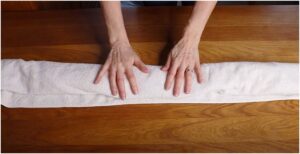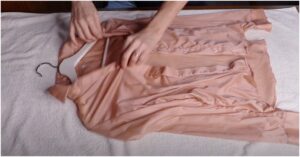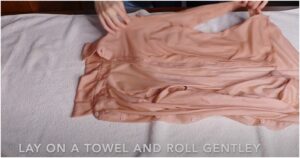
I learned How to Dry Satin the hard way—on a Sunday night, with a vintage silk slip, a looming event, and exactly zero patience. I wrung it like a dishcloth (rookie move), watched the shine dull, and vowed never again.
Since then, I’ve cared for dozens of satin pieces at Sew Mei Mei, teaching students how to protect that liquid-gloss look without stress, gimmicks, or heat disasters.
How to Dry Satin, step by step—what’s the safest routine?
Step 1: Remove Excess Water Gently

Image source- Marie-Anne Lecoeur – The French Chic Expert
After washing, skip the instinct to twist or wring. Wet satin fibers are fragile and more prone to permanent creases.
Lay the garment flat on a clean, dry towel.
Roll it up like a cinnamon roll and press along the length to blot moisture. If it’s still very damp, repeat with a second dry towel.
Step 2: Decide Between Flat Drying or Hanging

Flat Drying:
Best for preserving shape and avoiding stretch. Spread the garment on a fresh towel or mesh rack, smoothing seams and gently reshaping.
Hanging:
If you must hang, use a padded hanger and support heavy sections with cloth-covered clips. Only hang once most moisture is removed, never while dripping wet.
Step 3: Pick the Perfect Spot
Place your satin in a cool, dim, well-ventilated location.
Avoid sunny windows, radiators, or direct heat—these fade colors and weaken fibers. A shaded room with a soft breeze or a fan set a few feet away is ideal.
Step 4: Flip for Even Drying
If drying flat, flip your garment periodically to allow both sides to dry evenly. Replace any damp towels under it to prevent lingering moisture and speed up the process.
Step 5: Shape While Damp

As the satin nears dryness, gently smooth out any wrinkles and reshape hems, necklines, or seams with your fingertips. This keeps the piece looking tailored and reduces the need for heavy pressing later.
Step 6: Know Your Satin Type

Silk Satin: Always air dry—heat can cause shrinkage and loss of sheen.
Polyester Satin: Some pieces can handle a no-heat “air-dry” cycle in the dryer, but only if the care label explicitly says so. Remove while slightly damp and finish with air drying.
Step 7: Store It Right
Once completely dry, store satin in a cool, dark closet. Use padded hangers for garments and fold pillowcases or sheets neatly. Keep them away from sharp edges or rough fabrics that could snag.
Does satin get ruined when wet?
Not automatically. Being wet isn’t the villain—rough handling and heat are. Satin is a weave, not a single fiber type, so the risk depends on what it’s made of.
Silk satin is naturally delicate and more vulnerable to friction, high temperatures, and UV light. Polyester satin is tougher but can still snag, stretch, or lose polish if you wring, tumble, or sun-bake it.
The big hazards show up while the fabric is wet: fibers are more elastic and easier to distort.
That’s why wringing can cause permanent creases and why hanging heavy, water-logged pieces can stretch them out. Treat wet satin like a soufflé: gentle support, steady air, no shocks.
How long does satin dry?
Expect several hours, not minutes. In a room that’s cool and ventilated, lightweight tops or pillowcases often dry in 4–6 hours.
Thicker garments or gowns can take overnight. Humidity, fabric thickness, and how thoroughly you blotted make the biggest difference.
My trick: after the first towel roll, do a second roll with a fresh towel, then dry flat and flip halfway through. It’s the fastest path that keeps the surface smooth.

If you’re on a clock, focus on airflow, not heat. A fan placed a few feet away speeds evaporation while keeping fibers calm. Resist sunny windowsills; that “quick win” can cost you color and sheen.
Why can’t you put satin in the dryer?
Two reasons: heat and tumble abrasion. High heat can shrink or harden fibers, especially silk, and the constant tumbling scuffs the glossy surface. That’s how satin loses its mirror-finish or develops fuzz and snags.
There’s one narrow exception: some polyester satin garments allow a no-heat or “air-dry” cycle. Even then, it’s a calculated risk.
Check the care label, use the gentlest setting, and remove the piece slightly damp to finish flat. Never put silk satin in a dryer. Preserve the drape; don’t gamble it.
Where should you dry it—what’s the best spot for How to Dry Satin indoors?
Think cool, dim, and breezy. A shaded guest room with a ceiling fan on low is perfect. Keep pieces off radiators, away from heaters, and out of direct sun.
If you’re using a drying rack, leave space between garments so air can move freely. For flat drying, elevate your towel on a rack so both sides can breathe, and rotate the garment midway.
If your home runs humid, park a dehumidifier across the room. It makes an enormous difference and still avoids hot airflow that could rough up the face of the fabric.
What mistakes should you avoid during How to Dry Satin?
Skip wringing and twisting—those creases can “set” as the fabric dries. Don’t hang very wet satin; water weight stretches necklines and hems.
Avoid ironing while damp; moisture can make fibers vulnerable to pressure marks. And steer clear of sunny patches or high heat, which fade dye and flatten that signature glow.
If wrinkles happen, wait until fully dry to press from the wrong side on the lowest silk/synthetic setting with a pressing cloth—or, better yet, use gentle steam near the surface without touching, letting the fabric relax.
How to Dry Satin for clothes, sheets, and pillowcases—any tweaks?
Garments love the flat-dry routine. Smooth darts and seams with your fingers, then flip once as the towel gets humid. For bias-cut dresses, support the weight with a towel cradle across the rack so the bias doesn’t stretch.
Sheets and pillowcases are easier but bigger. After washing, do a generous towel roll, then drape pieces across a wide rack or a clean shower rod, keeping folds loose and even.
Flip partway through and run a low fan nearby. You’ll keep edges crisp without that “crunch” stiffening that hot air can cause.
How to Dry Satin when you only have a tiny space—what works?
Create a mini airflow lane. I place a mesh rack over the bathtub, crack a window, and set a fan in the doorway. Use thinner towels for the initial roll so things don’t stay swampy.
If you’re hanging, pad the hanger and add two soft-covered clips at the side seams to distribute weight. Short on towels? Layer with a clean cotton pillowcase under delicate areas—it wicks moisture beautifully.
Got quick questions about How to Dry Satin?
Can I speed things up with a hair dryer?
You can, but keep it cool and at a distance. Hot, concentrated air risks puckering and dulling the finish. A better plan is a regular fan placed a few feet away for steady, even airflow. If you must use a dryer tool, keep it on the coolest setting and moving constantly.
What if my satin looks dull after drying?
Often it’s residue or minor abrasion. First, ensure you used a gentle detergent and fully rinsed. Once dry, a whisper-light steam (no pressing) can re-plump the weave and revive reflection.
If it’s silk satin and still lackluster, the fabric may have been heat-stressed previously—focus on careful wash/rinse next time and avoid any hot cycles.
Is it okay to hang everything on padded hangers?
Padded hangers are good only after you’ve removed most moisture. For heavy pieces or bias cuts, start flat to prevent stretching, then move to a padded hanger when the fabric is just damp to finish. If you see any distortion, return to flat immediately.
How do I reshape a puckered seam while drying?
Lay the damp area on a towel and coax the seam line with your fingertips, gently nudging the fabric back into place. Let it rest flat for a bit, then flip and repeat if needed. Patience wins here—no tugging or ironing while damp.
Shall we keep that shine—ready to own How to Dry Satin?
You’ve got this. Treat satin like a small luxury moment: blot, shape, shade, and air. My final mentor tip? Plan your dry time.
Start the towel roll right after washing, set the piece in a cool, breezy corner, and resist shortcuts. The payoff is a garment that glows like new and lasts longer in your wardrobe.
If you try this routine tonight, send me a note from your laundry nook—I’ll be cheering you on, towel roll and all.



